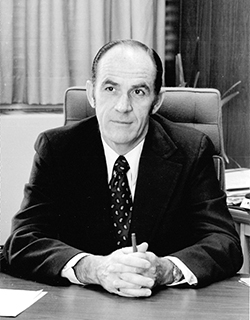Thomas D. Larson Biography
Thomas D. Larson: Ordinary Man, Extraordinary Legacy
To describe Tom Larson as a man who left a distinguishing mark would be true, but also a gross understatement. To say he posed a lasting challenge both nationally and industry-wide may be a more accurate description of the legacy left to us all by Tom Larson. Throughout his life, Larson advanced whatever he touched through his unique combination of vision, technical knowledge and creative drive.
Like many others in the field, Larson began his work as a student. After earning bachelor’s, master’s and doctoral degrees in civil engineering from Penn State and pursuing post-doctoral studies at Oklahoma State University and M.I.T., he worked as a Penn State professor. In this role, Larson was integral to the initial discussions in 1966 for establishing a transportation research center at Penn State.
In 1968, he co-founded and was named the first director of the Pennsylvania Transportation and Safety Center at Penn State, known today as the Thomas D. Larson Pennsylvania Transportation Institute. In its first year under his direction, the center doubled the number of participating University departments and increased its research expenditures from $48,000 to $700,000. Larson’s impetus at this time helped establish the Pennsylvania Department of Transportation in 1970, formerly the Pennsylvania Department of Highways.
Larson directed the Larson Institute until 1979, when he would be named Pennsylvania’s Secretary of Transportation. By that time, the Institute had conducted nearly $7 million in transportation research, with the participation of students and faculty from seven colleges and 22 departments, more than 30 graduate-level transportation courses, and over 1,000 publications and presentations. But Tom Larson’s watchword wasn’t simply progress; he consistently asked of himself and others: What can be achieved?
Larson’s invaluable contributions to the Commonwealth as Secretary of Transportation included centralizing control over state highway maintenance, reducing waste and winning significant federal highway aid for construction projects.
Engineering News-Record named him its national Man of the Year in 1982. Jim Scheiner credited him with turning PennDOT “into one of the best managed - and financed - public works agencies in the country.” During this time Larson also advocated for the crucial role of the Transportation Research Board in the complex atmosphere of technological advances and challenges to effectively apply new technology to America’s transportation needs.
In 1987, Larson returned to Penn State to serve as Pennsylvania Professor of Government and Management and Special Assistant to the university’s President. In this role, he was an active partner with former University President Bryce Jordan and others in establishing Penn State’s research park.
Two years later, his vision and energy were called upon to lead at the national level, where he served with distinction as Administrator of the Federal Highway Administration. From this vantage point, he led the preparation of the National Transportation Policy in 1990 and was actively involved in crafting the landmark Intermodal Surface Transportation Efficiency Act of 1991 (ISTEA).
He implemented a restructuring of the Federal-aid Highway Program and revisited the agency’s mission since the Interstate era began in 1956. He oversaw an FHWA reorganization and established an agency-wide strategic planning initiative that prepared the agency to better meet state and local needs in implementing ISTEA for the nation’s ever-increasing mobility needs. As FHWA administrator, Larson emphasized innovation and partnerships, renewed the commitment to environmental sensitivity as embodied in the FHWA Environmental Policy Statement of April 1990, reinvigorated motor carrier safety enforcement, and expanded diversity education and training for all employees. His tenure included a dramatic increase in the research, technology, and intelligent Vehicle Highway System programs and strong support for university transportation centers.
Early in the Larson Institute’s history, Larson initiated meetings with the leadership of other university-based research organizations, which eventually resulted in the formation of the Council of University Transportation Centers (CUTC). In 1988, during Larson’s service at FHWA, the UTC program was established, and he was instrumental in setting the program’s policies and management direction.
Upon his retirement from FHWA in 1993, Larson returned to central Pennsylvania and focused his energies on consulting and community activities. He served on the Schlow Library Board when the library embarked on a project to build a new facility, which today serves an active and growing community of children and adults. During this time, one of his greatest professional pleasures was his renewed involvement with the larson Institute as a member of the Institute’s Advisory Board. As he had from the beginning, Larson remained a vigorous advocate for the multidisciplinary focus of the Institute’s energies, which he considered a key strength and in sync with the direction of the transportation industry.
Tom Larson’s story would be incomplete without noting the breadth of his service and honors bestowed on him. He served as president of the American Association of State and Highway Transportation Officials and chaired the National Governors’ Association Task Force on new federal transportation legislation. He was a member of the National Academy of Engineering as well as many public and professional organizations. He was also an active leader in the American Association of State Highway and Transportation Officials and the Transportation Research Board. His many honors include TRB’s William N. Carey, Jr. Distinguished Service Award (1992), Construction Man of the Year Award from the Engineering News Record (1982), the American Society of Civil Engineers President’s Medal (1993), AASHTO’s George S. Bartlett Award for Highway Progress, and Penn State’s Distinguished Alumni Award (1990).



